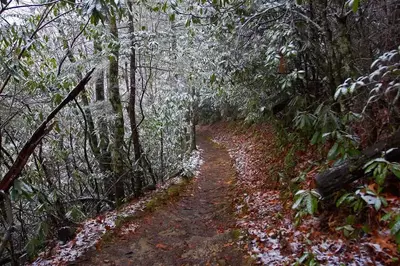While there may be some snow and icy patches on the trails in Smoky Mountains National Park during the winter months, it is a wonderful time for a scenic hike! There are not only far fewer crowds than the summer season, but the gorgeous winter landscape is simply breathtaking! If you do decide to head out for a winter hike, there are several preparations that you should keep in mind. Here are 4 essential safety tips for winter hiking in Smoky Mountain National Park:
1. Inform Others of Your Plans
When you go on any hike, it is standard practice to inform others of your specific plans. This is especially important during the winter months in the Smokies as the conditions are more challenging and the hours of sunlight are shorter. You should tell your contact the exact trail you will be hiking, the time of your departure and when you expect to return. Therefore, your contact can be lookout for your return and will know if something is out of the ordinary.
2. Dress for Unexpected Conditions
Another essential tip for winter hiking in Smoky Mountain National Park is to dress for unexpected conditions. While the temperatures may seem moderate upon your departure, the weather conditions can change rapidly in the Smokies. So even if the forecast calls for clear skies and sunshine, you will need to dress in layers. This is because the winter temperatures can range anywhere between freezing near the top of the mountains to 70 degrees in the lower elevations! It is recommended that you bring a waterproof winter hat, gloves, a ponco and an extra pair of socks in the event of rain or sleet.
3. Bring Hot and Cold Drinks
While it is common sense to bring plenty of water on a hike to stay hydrated, this is extra important on a winter hike. This is because during the winter, water loss occurs both through perspiration AND respiration. Although you can regulate your perspiration rate by slowing down your pace, most people don’t even realize they they are losing water through respiration. You should bring at least two quarts of water to keep hydrated at all times. You should also bring along a Thermos with a hot drink to keep your body from getting chilled during cold temperatures.
 4. Be Prepared for the Elements
4. Be Prepared for the Elements
The obvious difference between summer and winter hiking in Smoky Mountain National Park is the presence of ice and snow. The best way to stay safe is to remain on the marked trails at all times so that you don’t get lost or encounter any issues. If you bring along hiking staffs or trekking poles, they will help you around the steeper and more slippery patches along the trails.
Now that you know how to be adequately prepared for winter hiking in Smoky Mountain National Park, you can enjoy a fun and safe adventure on the trails! The Smokies are a delightful place to visit at any time of year, so learn more about what to expect from the Smoky Mountain weather throughout each season.








